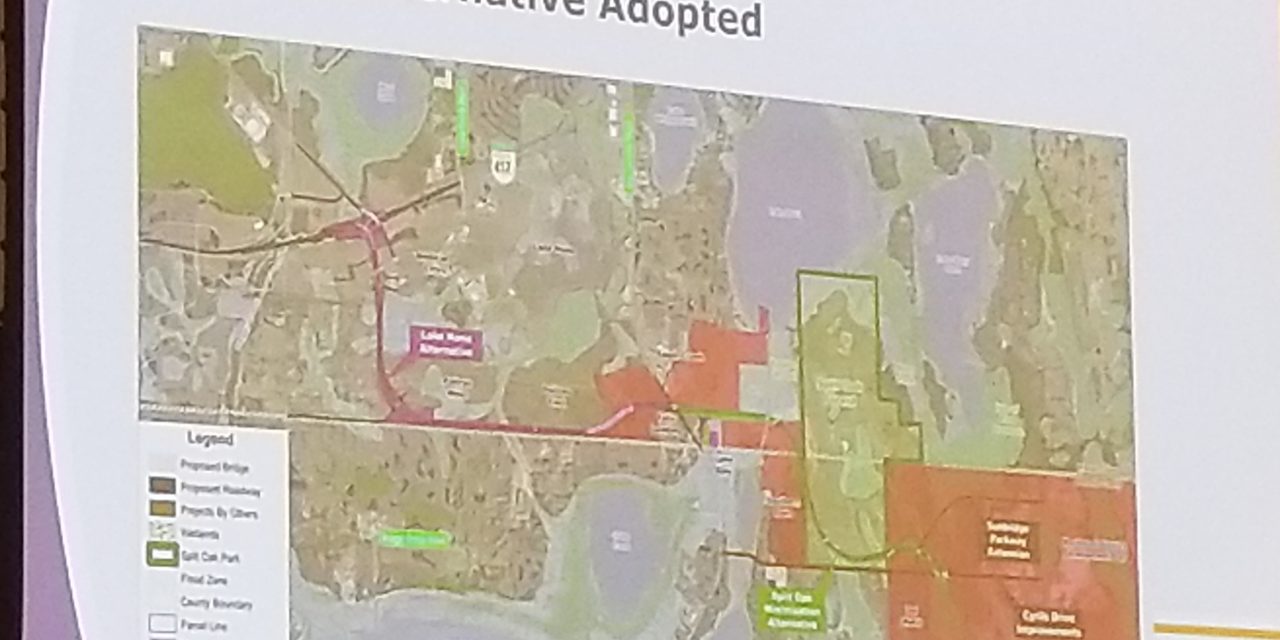Despite two hours worth of pleas from the public to not disturb land that had been secured by government officials 25 years ago, the Board of Osceola County Commissioners voted to approve the region’s toll board’s plan to run a new road through a portion of it.
Monday, the Central Florida Expressway Authority approved a plan for an eastern extension of the Osceola Parkway that will affect a portion of the Split Oak Mitigation Area, which straddles the Osceola and Orange county lines. Tuesday, it passed Osceola’s board with a 4-1 vote; Commissioner Peggy Choudhry cast the dissenting vote.
“A decision like this is never easy. The issue isn’t growing and that we don’t want connectivity,” she said. “The overall the issue is, what do we do as leaders and residents when we think something we protected, and why can the government go and change that? What are the options?”
Orange County officials are set to vote whether to approve the plan today (Tuesday).
The parkway extension, part of a proposed beltway that rings an urban growth boundary, that prevents dense subdivisions being built outside it, is part of a 40-year roadway plan originally created by the Osceola County Expressway Authority and included in the CFX 25-year plan.
Plans for the road, which is set to go from State Road 417 south of Orlando International Airport east and south to an interchange with Narcoossee Road, originally drawn up last year bisected the Split Oak forest, which was acquired for $6.8 million in 1994 to preserve wetland mitigation and gopher tortoise habitats and will become part of the Florida Nature Scenic Trail next year. It totals 1,684 acres, 690 in Osceola.
But because of backlash from groups like Friends of Split Oak, who have gone as far as file suit against Osceola County, CFX shifted its proposed route far south to minimize impact to the forest, even calling the new plan the Split Oak Minimization Plan. That plan earned the support of local Chamber of Commerce groups that see the economic impact of new development the road will enable.
But it didn’t placate the opposition, who spoke en masse on Tuesday. Many expressed disappointment with commissioners for breaking their trust to support the road through land thought to be in conservation “in perpetuity” and paid for by taxpayers – a road that more than one speaker noted doesn’t connect to existing Osceola Parkway, but serves as an access road to future development.
“This doesn’t address current needs. It’s a development-enabling road,” said Valerie Anderson, who represents the Friends of Split Oak.
In seeking approval, Tawny Olore, the director of transportation and transit in Osceola County, said Florida statute that use of conservation areas for “linear features” like roads can’t be restricted as long as a state agency has determined there is no other reasonable alternative and that the land use is designated to have minimal impact to the site.
CFX Chief of Infrastructure Glenn Pressimone said the road had been considered for the past 15 years, and would meet five objectives: provide new connections to existing area roads, accommodate anticipated transportation demand, provide consistency with regional plans, support economic viability and job creation, and support multimodal opportunities.
Commissioners Cheryl Grieb and Brandon Arrington, who made and seconded the motion to approve the plan Monday, lauded those who so vocally and fervently support the Split Oak Forest but saw the road as a move toward progress.
“This process has been my most difficult decision as an elected official, because we have to look at future needs of the county,” Grieb said. “When I look at the trade-offs and the needs for restoration, I know that growth is coming.”
Arrington said those people had an impact on the decision, which lessened the impact on the forest and prevented those just to the west of the Osceola portion of the project from losing their homes, although it will ultimately affect 15 residential parcels along Cyrils Road east of Narcoosee Road.
“I thank everyone for their passion,” he said. “People had impact on this decision by your participation. But until the state takes away your land rights, you have the right to sell and develop your land as you see fit.”
Choudhry reiterated those who supported the forest didn’t waste their time.
“I love to see the ‘boots on the ground’ movement of people like Valerie Anderson,” she said. “It made CFX try to find something better.”




















